Here’s a brief look at the Sony 55-200mm F/4-5.6 telephoto lens. Scroll down for the main review.
|
Lens
|
|
|
Box contents
|
Front and rear caps, hood and users manual.
|
|
Cost
|
|
|
Build quality
|
Good, but plastic mount.
|
|
Additional information
|
Similar to the more versatile Sony 75-300mm but less expensive.
|
Specifications below
|
|
|
Optical configuration
|
13 elements in 9 groups
|
|
Angle of view
|
29°- 8°
|
|
Aperture
|
9 blades, circular
|
|
Full frame and APS-C
|
APS-C only. Equivalent to 82.55-300mm. Not for full frame, but will work, see note under performance.
|
|
Depth of field and focus scales?
|
No and no
|
|
Minimum focus, image plane to subject
|
37″ (940mm)
|
|
Minimum focus, end of lens barrel to subject
|
29.75″ (756mm)
|
|
Hard stop at infinity focus?
|
No
|
|
Length changes when focusing?
|
Yes
|
|
Focus ring turns in AF?
|
Yes
|
|
Filter size
|
55mm
|
|
Filter ring rotates?
|
Yes
|
|
Distance encoder?
|
Yes
|
|
Max magnification
|
0.29x
|
|
Min. F/stop
|
F/32-45 listed wrong on Sony’s website
|
|
Sony teleconverter compatible?
|
No
|
|
Length changes when zooming?
|
Yes
|
|
Dimensions WxL (my measurements)
|
2.8″ x 3.3″ 71mm x 84mm
|
|
Maximum extended length (my measurements)
|
5.3″ (135mm)
|
|
Weight bare (my scale)
|
10.5oz (297g) 11.3oz (321g) with caps
|
Requisite product shots.
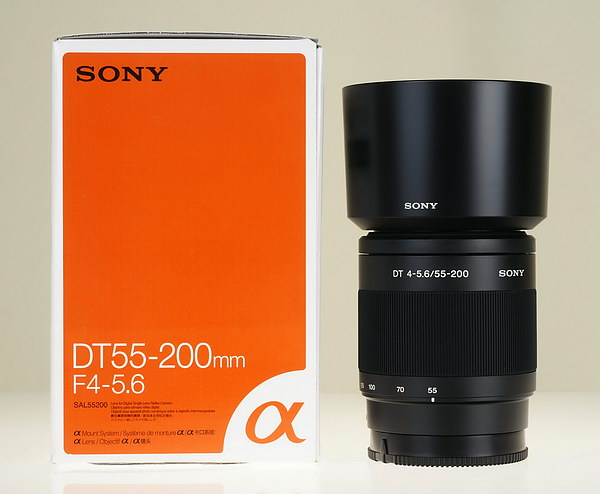 |
| Box and contents. |
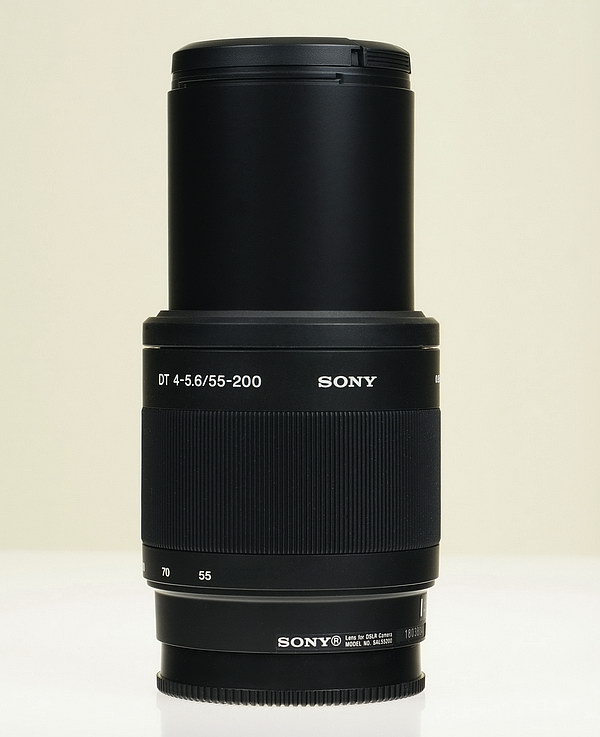 |
| Fully extended |
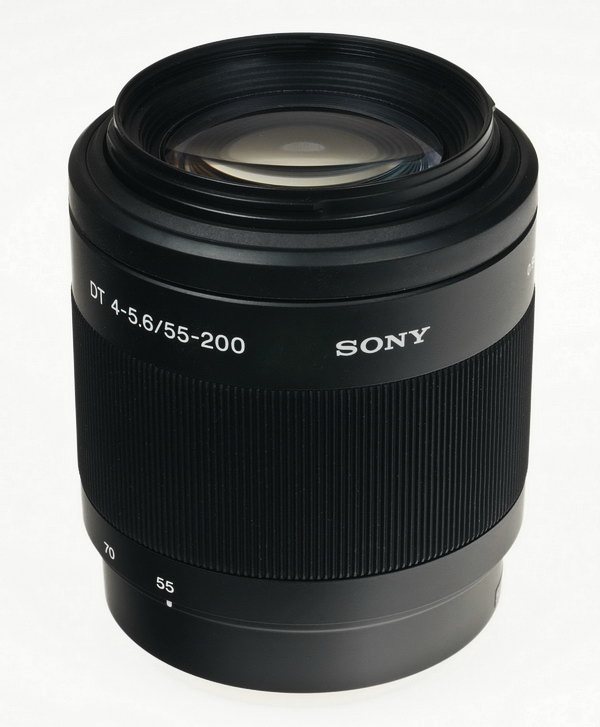 |
| Drawn in. |
 |
| Rear, plastic lens mount. |
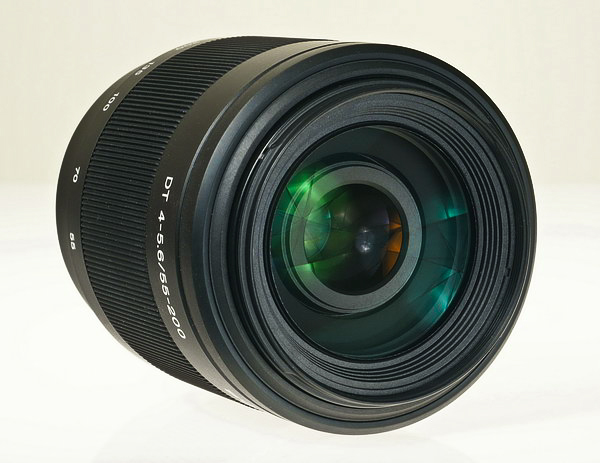 |
| Front element. |
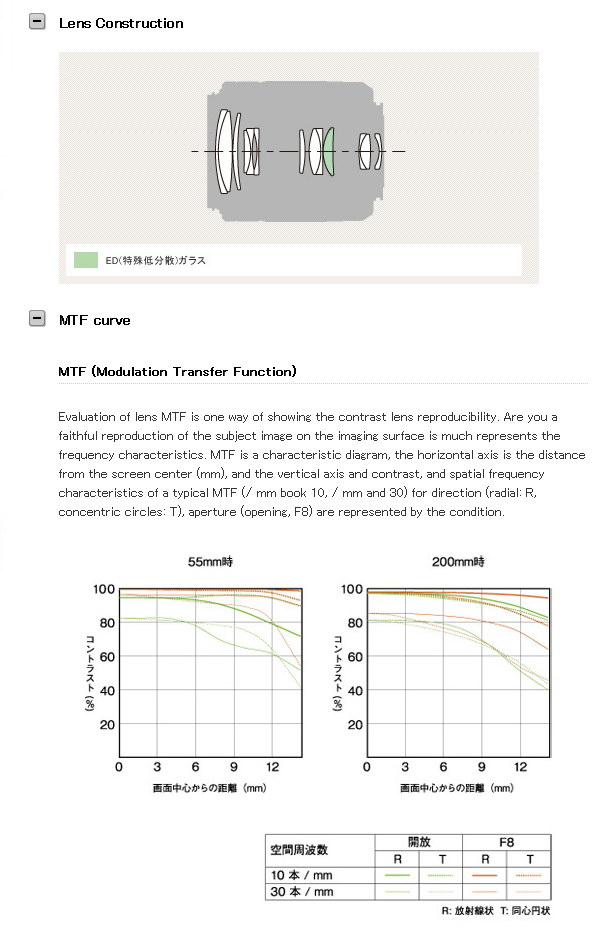 |
| Sony X-ray view and MTF chart |
The
Sony A700 was used for this review. For a better understanding of my review methods and terminology,
go here.
The Sony 55-200mm makes a good companion to the “kit” lens offered by Sony on the latest models. With a 3.6x zoom and focal length equivalent of 82.5-300mm, you can bring your subject up pretty close, though this isn’t the only telephoto lens offered in this price range, also consider the Sony 75-300mm F/4.5-5.6, which can be a more versatile lens. More on that later.
The lens has a matte black finish, with white numbers to indicate focal length. They come at 55mm, 70mm, 100mm, 135mm and 200mm. The EXIF data matches up with the lens focal length marks. Size-wise, the lens is about 3-1/2″ long closed, and 5-1/2 fully extended at 200mm, including the half inch for the focus extension. This lens says “China” so I assume it’s made in China. Construction is mostly plastic, as expected, and also has a plastic mount, but the fit and finish are good. The zoom effort is about right, it doesn’t seem to want to “creep” out as you walk, and there’s no zoom lock if it did. Sony claims it has 1 ED glass element inside.
The chart below shows the focal length and corresponding maximum apertures. You go all the way to 100mm at F/4, which is good, then hit F/4.5 up to 160mm. You’ll get F/5 up to 180mm, then it’s F/5.6 to 200mm.
Aperture chart for the Sony 55-200mm F/4-5.6
|
Maximum aperture
|
F/4
|
F/4.5
|
F/5
|
F/5.6
|
|
Range
|
55mm-100mm
|
105mm-150mm
|
160mm
|
180mm-200mm |
Performance. The lens focuses quickly and accurately, especially with the A700. The manual focus ring located at the end of the lens works ok, but it’s typical of inexpensive lenses, meaning the window of sharp focus can be hard to get, with the slightest movement throwing it one way or the other. The filter ring turns as you focus which can be a pain in the behind if you have a polarizer or graduated filter mounted. From close-in to infinity takes a 1/4 turn, very common for Sony lenses. The lens is pretty light for a telephoto. It weights about the same as the Sony 50mm F/2.8 macro lens.
This lens gives full coverage on a full frame camera, though there’s some heavy vignetting at close focus between 55-110mm. Unfortunately, you cannot turn off the auto-crop using a Sony DT lens with the A900.
Bokeh, or background blur samples below.
|
Bokeh, 55mm @ F/4
|
Bokeh, 55mm @ F/5.6
|
 |
 |
|
Bokeh, 200mm @ F/5.6
|
Bokeh, 200mm @ F/8
|
 |
 |
Bokeh. The Sony 55-200mm F/4-5.6 has harsh bokeh at F/4 around 55mm, then smoothing out some at F/5.6. Towards the long end, it’s just ok, and not quite as smooth as the other Sony zooms in this range.
 |
| 55mm, no problems here. |
 |
| 200mm, moderate to heavy pincushion. |
Distortion is very low At 55mm and basically flat, but pincushion shows moderate to heavy levels towards the end of the zoom.
Lens flare and ghosting is not much of a problem, at 55mm there’re one or two small green blobs that show up, then towards 200mm, there’s almost nothing. Veiling glare can be strong towards the long end. Use your hand to block stray light and solve the problem. The included lens hood is adequate for 55mm-100mm. Overall, good control here. If you lose the hood, plan on spending $25 to replace it.
Color is the same as other Sony lenses.
Filter size is 55mm. This is the most popular filter size in the Sony lineup. Other lenses using this size are: 35mm F/1.4, 50mm F/1.4, 50mm macro, 100mm macro, 18-70mm, and the 75-300mm.
Filter use. Normal filters cause no additional vignetting on this lens.
Close up filter use. Good results at 55mm using a +4, don’t use it at the longer lengths or it turns into a mess.
Lateral color fringing. Average here. In normal situations it’s not very noticeable, but high contrast areas like white rooftops against dark A/C units can show quite a bit of old fashioned purple fringing, which is the dominant color. At 55mm, it’s not nearly as noticeable as it is at the long end. Stopping down doesn’t do any good with this type of color fringing. See corner crops down the page for an example.
Light fall-off.
As you can see, light fall-off or corner shading is not much of a problem on the Sony 55-200mm lens. Wide open, you’ll notice a small amount at 55mm and F/4, but it clears up nicely one stop down at F/5.6. At the long end, there’s no problem. Real photos show no dark corners.
|
55mm @F/4
|
55mm @ F/5.6
|
|
|
|
|
200mm @F/5.6
|
200mm @ F/8
|
|
|
|
Center and corner sharpness.
Below are crops from the centers at 200mm.
200mm corner crops below.
Stopping the lens down at 200mm really doesn’t do anything for long telephoto shots like this, at shorter distances without the atmosphere and heat shimmer you see sharper results by stopping down to F/8. In the case of the photo crops above, F/5.6 looks as good as F/8, then by F/11 it softens up a bit. These images aren’t the greatest, but they show real life. Look at the vent in the roof at the right, you can tell it’s sharper at F/5.6 than F/11. The two corner crops (directly above) show some sharpening at F/8, but that’s it, stopping down to F/11 makes no difference. Notice the purple fringing too.
|
55-200mm @ 200mm F/8
|
|
|
75-300mm @ 200mm F/8
|
|
Comparisons with the Sony 75-300mm F/4.5-5.6.
The top image is not as sharp as the 75-300mm is at 200mm. Again, look at the roof vent on the right side.
|
55-200mm @ upsampled to 300mm F/8
|
|
|
75-300mm @ 300mm F/8
|
|
Just for fun I thought I’d compare the two lenses at their maximum lengths, so I upsampled the 55-200mm to match that of the 75-300mm. Both are equal to 300mm. As you can see, there isn’t all that much difference, but the 75-300mm does do a slightly better job.
|
Sony 55-200mm @ 200mm F/8
|
|
|
Sony 18-200mm @ 200mm F/11
|
|
Above I’ve compared the 55-200mm with the 18-200mm lens. They both look the same, but the 55-200mm is sharper at a wider aperture, the 18-200mm needs F/11 for best results.
Centers at 55mm below.
|
55mm @F/4
|
55mm @ F/5.6
|
|
|
|
|
55mm @F/8
|
55mm @ F/11
|
|
|
|
The centers at 55mm are pretty sharp with the aperture wide open. One stop down at F/5.6 looks the sharpest, barely. F/11 looks a little soft due to diffraction. Notice the small amount of color fringing in the centers around the bright reflections, this isn’t noticeable unless blown way up on a computer screen.
55mm corners below.
|
55mm bottom left corner @F/4
|
55mm bottom left corner @ F/5.6
|
|
|
|
The corners (above) look slightly sharper from F/4 to F/5.6 at 55mm, the darker left shot is from light fall-off.
Let’s check out the macro capabilities of this lens.
Below, check out the sample and click the picture to see a 100% cropped portion of the full image (383kb file). The sample shot was taken with the
Sony A 700 12.2MP camera. The subject is a standard US stamp, 1″x 3/4″ or 25.4mm x 19mm. Also, note the macro shot was taken as close to the subject as focusing allowed; in this case a whopping 29.75″ or (756mm), measured from the front of the lens barrel to the subject.
The 0.29x macro is very sharp at the long end, coming at F/8, which is unusual for Sony less-expensive lenses, a good job here.
 |
| As close as you can get macro, at F/8. |
Here are my
final thoughts on the small
55-200mm F/4-5.6 telephoto lens. The lens is sharp, even at maximum apertures, and the corners look fine about one stop down. This lens will give good results when used wide open, contrary to the Sony super zooms, which need to be stopped down hard at the long end to look sharp. As with most telephoto zoom lenses, there is some color fringing, but it’s about average for Sony, and has the same or slightly better control than the 75-300mm I’ve been comparing it to here. Distortion and light fall-off are average and match that of the 75-300mm. Bokeh is good to just ok depending on aperture and zoom length. The macro shot is much better than the 75-300mm. Overall, I like this lens. Check out the
Sony 75-300mm and see if it meets your needs better than this one.
Who would be in the market to buy this lens? The typical purchaser is someone who wants convenience and low price. If you have the Sony 18-70mm kit lens only, and want a nice light zoom, but don’t think you’ll ever use over 200mm in focal length, I’d highly recommend this lens. This is a great lens to take with you when you want to travel light. On the other hand, if you already have an 18-200mm or the 75-300mm, I think I would pass on this lens, as it isn’t much different at the telephoto end, and not quite as sharp at 200mm as the 75-300mm.

































